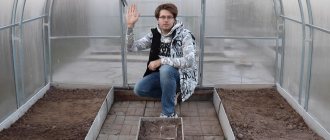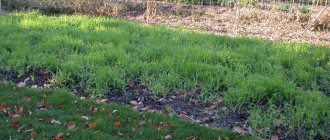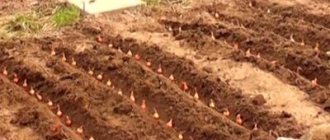One of the most popular and beloved root vegetables is radish. The popularity of the vegetable is to some extent explained by the fact that it ripens quickly. Some varieties can be picked after germination within three weeks. Therefore, many gardeners plant radishes in greenhouses and open ground in the fall before winter. In this case, fresh root vegetables will be on the table in spring or early summer. But in order not to make a mistake and get an early harvest, you need to choose a variety suitable for winter sowing and know when and how to plant radishes before winter.
Choosing varieties for winter sowing
How to plant radishes is already known, all that remains is to decide on the plant varieties for winter planting.
The main criteria for choosing varieties should be resistance to bolting, frost, and lack of light. Experienced summer residents recommend using the varieties “Zhara”, “Zarya” and pink-red with a white tip for winter planting. “Heat” and “Zarya” are early ripening, the first ripens in 15-18 days after germination, the second in 18-25 days. “Zarya” is also valued for its high yield and slightly spicy but mild taste. In addition to good yield, it boasts resistance to low light, which is very important for winter plantings.
The pink-red radish variety with a white tip is a mid-early variety, it ripens 25-30 days after germination. The main advantage of this variety is its pleasant taste, which is very popular among summer residents.
Planting radishes before winter is a risky undertaking, but if you do everything correctly, then at the beginning of spring you will have fresh, vitamin-rich vegetables on your table that will undoubtedly bring a lot of benefits to your health!
What care is required
Seed care ends after planting and begins again after warm weather sets in.
When the first shoots appear, you need to start thinning them out.
If the sprouts appeared in early spring, when the soil may freeze, then the bed must be covered with polyethylene or agrofibre. This action will protect the seedlings from freezing and the active sun will not burn the young leaves.
From this moment you can begin active watering, since radishes are a moisture-loving plant and cannot tolerate dry soil.
If the seedlings do not have enough moisture, the harvest will have a bitter taste. If there is too much liquid, the root crop turns out watery and tasteless.
It is also necessary to water each bed evenly, this will make it possible to obtain dense and whole radishes.
Particular attention must be paid to breaking through weeds, which clog the soil and prevent garden crops from developing normally.
Young seedlings can be fed with special fertilizers or bird droppings can be mixed with water and left for 10 days. You can water the seedlings with the resulting mixture every day; this natural fertilizer will give the sprouts strength for further development.
Due to the death of some seeds, gaps can be seen in the beds, so gardeners recommend combining autumn planting with spring planting.
Sometimes even radishes sown before winter can be attacked by a pest, so it is necessary to treat them with a mixture of ash and lime, taken in equal proportions.
To keep the fruit longer, it is necessary to stop watering before harvesting. Then they pull out the root crop with their hands and wash it under running water, collect it in bunches and cut off the tops.
For open ground
When choosing the best varieties of radishes for open ground, you should take into account the fact that they differ in terms of ripening.
Early ripening or ultra-early varieties have a ripening period of up to 20 days. The most popular are:
Early ripening varieties of radishes differ in ripening time from the moment of germination - up to 30 days. The best are considered:
- Heat;
- White Fang;
- Sachs;
- French Breakfast;
- Ilka.
Mid-season varieties have a ripening period of up to 35 days. You can choose from the most popular:
- Duro;
- Quantum;
- Faith;
- Würzburg 59;
- Autumn Giant;
- Alba.
Late-maturing varieties require 35 to 45 days from germination to harvest. The best are considered:
- Rampoush;
- Dungan;
- Ice icicle;
- Red giant.
For the greenhouse
To achieve a good harvest of a vitamin vegetable planted in early spring, you should choose varieties that are resistant to reduced light. The best of them are high-yielding varieties:
- Heat;
- Silesia;
- Diego;
- Violet;
- Krakowianka;
- The Snow Queen;
- Zlata;
- Ruby;
- Champion;
- 18 carat;
- Helios;
- Rondar;
- Confetti;
- Mokhovsky;
- Frenchpop;
- Deca;
- Angelica;
- Malaga.
You will be interested to know: Turnip plant: planting and care in open ground, when and how to plant
How to grow radishes
Caring for radishes will not take much time, especially if the crops were covered with mulch. When caring for radishes, you must follow these simple rules:
- Watering radishes. Almost everyone knows that radishes love watering and when there is a lack of moisture in the soil, they begin to bolt. At the same time, the roots of plants growing in waterlogged and not drying soil will crack. Therefore, the soil must be kept slightly moist. To do this, on warm and dry days, plantings are watered in the morning and evening, and if it rains regularly, then one watering in the morning or evening will be enough.
- Weeding and loosening. Plantings must be freed from weeds, especially while the plants are still young. In order for air to flow to the roots of the plants and for them to develop better, after weeding, the soil between the rows is carefully loosened. If you mulch the garden bed, there will be much less weeds growing on it, which will make it easier to maintain.
- Radish feeding. Many gardeners ask the question - how to feed radishes to get a good harvest? If the soil on the site is fertile, then during plant growth one fertilizing with mineral fertilizers will be enough. Radishes growing in poor soil are fertilized twice, using not only mineral fertilizers, but also organic matter in the form of humus and compost.
How to plant radishes correctly
To sow radish seeds, furrows or holes are made in the garden bed with a distance between rows of about 15 cm. The seeds are planted to a depth of two centimeters in moist soil (the holes or furrows are pre-watered abundantly).
To get a good harvest, it is recommended to plant radishes at a distance of three to five centimeters. You can sow the seeds often, and when the plants grow a little, thin them out. However, in this case, when pulling out a weak seedling, the roots of a nearby growing plant can be damaged. Therefore, it is better to spend a little time and plant radishes at the distance necessary for their development.
The planted seeds are first sprinkled with soil and then with a two-centimeter layer of mulch. You can use humus or peat as mulch, which will retain moisture in the ground. Before the seedlings appear, the crops are covered with film.
If the spring turns out to be warm and sunny, then the first shoots should appear in three to four days.
We invite you to familiarize yourself with Dome houses: projects, photo examples and construction features
Treatment of radish seeds when planting before winter
You can sow radish seeds in open ground without preparation. Some gardeners prefer to soak them before planting. If you keep them in a damp cloth or gauze for 1 to 4 days, they will come off more easily and quickly. Growing radishes in a greenhouse involves the use of selected seed material. In this case, it is better to calibrate. For this you will need a fine (cell diameter 2 mm) sieve. Small seeds are discarded and the remaining ones are planted. You can select material for sowing manually. The larger the seed, the more powerful the plant will be, which means the larger the root crop.
The next step is disinfection. The seeds selected for sowing are kept in a strong solution of potassium permanganate for 30 minutes. This measure improves their germination and prevents the development of fungal diseases. Another option is to soak the seeds in hot water for 20 minutes. This will protect the plants from dry rot. Heat treatment is carried out immediately before sowing.
The secrets of professional radish planting lie in labeling its seeds. After keeping them in an iodine solution (1%) for 5 minutes, they are sprinkled with chalk or lime. White seeds are clearly visible on the ground and will be easier to distribute them evenly in the garden bed.
Which varieties of radishes to choose
Pre-winter planting requires the following qualities from the plant: it must be frost-resistant, tolerate a lack of sunlight and not have a tendency to go wild when there is a sudden change in weather conditions.
Breeders have developed varieties that meet these requirements:
- Heat (fruit ripening lasts 15–18 days);
- Zarya (root vegetables are ready to eat in 18–25 days);
- radishes are pink-red, mid-early (ripening - 25–30 days after seedlings appear).
For autumn planting of radishes before winter, experts have developed certain varieties suitable for the required weather conditions.
The top three in terms of frost resistance and early ripening include such varieties as Yubileiny, Mayak, Spartak, and Carmen.
When to plant radishes in a greenhouse and open ground
For growth and development, radishes need a 13-hour daylight hours and an air temperature within 15... 20 degrees. Therefore, in the southern regions, radishes can be planted in a greenhouse as early as March, and in Siberia and the Urals, seeds are sown under film from mid to late April.
When choosing a day to plant radishes in open ground, you need to focus on weather conditions:
- radish seeds germinate at a temperature of 2 degrees;
- vegetables are not afraid of short-term frosts down to -3 degrees;
- at temperatures above 18 degrees and short daylight hours, only the tops will grow, but the root crop will not grow.
Knowing these features of growing radishes, you can easily understand when to plant radish seeds in open ground and greenhouses in your region.
To always have fresh radishes on the table, they are planted in stages. To do this, the next sowings are carried out after the already planted seedlings have grown full-fledged leaves.
Radishes can be planted and harvested throughout the summer.
How and with what to insulate a bed with crops
While it is not yet very cold outside, autumn radish crops in the open ground do not need to be covered. With the onset of cold weather, mulch them with a 3-5 cm layer of humus or peat. On top, add an additional layer of dry leaves, straw or tops of 15-20 cm. You can cover it with spruce branches if it does not need to be specially torn off.
It is enough to cover a bed with radishes planted in a greenhouse in the fall with snow when it falls. If the winter is expected to be cold, then pre-mulch the bed, as in open ground.
Pay attention to the weather forecast. In cold winters with little snow, it is necessary to add additional snow to the beds with autumn crops.
When to plant radishes before winter
In the fall, when frosts begin, you can sow radish seeds, preparing the bed in late summer. In different regions, frosts begin at different times, so you need to focus on the weather. In central Russia, planting is usually done from mid to late November. In colder regions, winter radishes are planted in October.
The harvest of radishes planted in the fall can be harvested next year two weeks earlier than those sown in the spring.
You can find out when to plant radishes according to the Lunar calendar this year if you follow the highlighted link.
Radish varieties that can be planted in the fall before winter
For autumn planting, choose radish varieties that are able to germinate and develop at low temperatures. In this case, seedlings will appear in early spring, as soon as the ground warms up.
Suitable radish varieties for sowing before winter:
- Carmen;
- White Nights;
- Mercado;
- Icicle;
- Anniversary;
- Blue frost;
- Lighthouse;
- Zlata;
- Spartacus;
- Torero.
Thanks to breeders, many new varieties appear every year. We recommend asking consultants in specialized stores. Perhaps this year some new good varieties of radishes have appeared that are suitable for winter planting.
When to sow radishes?
Radishes have a short growing season - on average, 4 weeks pass from sowing to harvesting. Therefore, many gardeners, when stable warmth sets in, plant radishes in open ground every 7-10 days - and so on all spring. As soon as the old batch of root vegetables is collected, a new one is on the way!
Most radish varieties can be sown continuously throughout the spring - from March-April until the end of May, and then in August.
On the longest and hottest days of summer (especially June), a break is taken. Why? The fact is that radishes are short-day crops. Ideally, to grow a root crop, it requires 10-12 hours of daylight. If the day lengthens to 13-14 hours, and the air temperature rises to 25 degrees or more, most radish varieties begin to bloom (shoot). In this case, the root crop is small and skinny, since the plant spends all its energy on flowering and producing seeds.
However, if you really want to have fresh radishes on the table all summer, you can do the following:
- Or cover the radish plantings every evening with dark non-woven material (spunbond, lutrasil) to shorten the daylight hours to 10-12 hours. For example, cover from 7 pm to 7-9 am.
- Or, during the “difficult” period of summer, grow special non-shooting varieties of radish: Duro, Duro Krasnodarskoe, Malaga, Yum-Nyam, etc.
The second option - planting radishes of non-shooting varieties - is the most reliable and will not require unnecessary movements on your part. Look for information about bolting tendency on the seed packets. If the variety is not prone to flowering, this will be indicated by the manufacturer.
Radish Duro Krasnodar can be grown throughout the season; it is resistant to bolting (blooming) and sagging
Gardener's lunar calendar for March 2022
March is the traditional month for planting many seeds for seedlings, including according to the lunar calendar. In addition, other events can be held in the garden. The lunar sowing calendar for March 2022 recommends doing agricultural work in the following sequence:
- 1-2. You can plant radishes, carrots, and beets in the greenhouse. The moon at this time is in the constellation Capricorn, this has a positive effect on crops.
- 3-4. At this time, it is recommended to deal with already planted plants: weed, loosen the soil, hill up. You should not engage in planting and replanting, as well as apply fertilizers, since the Moon, which is in the barren sign of Aquarius, will have a negative impact on them.
- From 5 to 9. It is not advisable to disturb the plants. You can do preparatory work related to the ground. This is the period of the new moon, the Moon at this time successively passes through the constellations of Pisces and barren Aries.
- 10-12. During this period, it is recommended to plant tomato and cabbage seeds for seedlings. You can plant radishes and greens in a greenhouse. This is a favorable time to remove potatoes from winter storage for germination. The fertile constellation Taurus will have a beneficial effect on planting.
- 13-14. A favorable time for planting greens, as well as onions. You can do all the work related to soil cultivation. The Moon, located in the neutral constellation Gemini, will not have a noticeable effect on crops.
- 15-16. During this period, it is recommended to plant tomatoes, peppers, cucumbers, and cabbage seedlings. At this time, the finished seedlings can be planted in a heated greenhouse. At this time, the Earth's satellite is in the most fertile of all signs - Cancer. Therefore, even the most demanding and delicate crops planted during this period will sprout well and develop well.
- 17-18. It is not recommended to do any garden work at this time. The Moon is in the barren constellation Leo.
- From 19 to 20. It is recommended to engage in work related to the earth: loosening, weeding, hilling. There is no need to deal with seeds and seedlings these days. During this period, the moon is in the neutral constellation Virgo and will not have any significant effect on the plants.
- 21 March. Full moon, state of rest. No work is carried out at this time.
- You can plant early carrots and radishes in the greenhouse. The constellation Libra, in which the Earth's satellite is located at this time, is neutral and will not affect plants.
- 23-24. It is recommended to plant root crops and seedlings. You can plant seeds of peppers, cabbage, and tomatoes for seedlings. The moon at this time is in the fertile constellation Scorpio, which will have a good effect on the harvest.
- 25-27. A good time to plant spring garlic, radishes, and onions, if weather conditions permit. Parsley, celery, and dill planted during this period will produce good shoots. The Moon, located in the constellation neutral Sagittarius, will not have a noticeable impact on the crops.
- 28-29. During this period, you can plant potatoes, beets, onions, carrots, and radishes. Vegetables planted at this time will have the longest shelf life. The Earth's satellite is located in the fertile constellation Capricorn.
- 30-31. These days are not suitable for planting and working with plants. The infertile sign of Aquarius will negatively affect plants.
We invite you to familiarize yourself with the best soup dressing for the winter with vegetables
on the influence of the lunar calendar on plantings:
Preparing for sowing
A good harvest consists of several stages, which, conditionally, can be divided into four groups: planning, preparatory procedures, planting, care.
The place for sowing radishes should be chosen in advance. The ideal option is an area protected from wind and drafts, illuminated by the sun in the first half of the day. Away from tall trees, buildings, fences.
Radishes and garden crops of the cruciferous family cannot be grown successively in one garden bed. These include cabbage, mustard, radish, and daikon. Plants are susceptible to the same diseases and pests. The cultivation of other crops can be alternated.
Radishes feel great in mixed beds next to parsley, bush dill, lettuce, spinach, carrots, and onions. The proximity of beds with leaf and head lettuce to radishes will protect the crop from cruciferous flea beetles, and proximity to bush beans improves the taste of the fruit.
Planting radishes before winter and its features
The recommended depth for planting radish seeds is at least two centimeters. The interval between rows should be about 20 centimeters. In the last month of autumn, winter radishes are planted. Autumn radishes are most often sown in the second half of November. Not all varieties of radish are suitable for winter sowing (there are certain varieties of the vegetable for sowing in a greenhouse).
We invite you to familiarize yourself with How is limestone formed in nature?
The preparation of the place for sowing is carried out in advance, in the last days of August. The soil should be dug up and fertilized (humus, compost, superphosphate, potassium sulfate). After fertilizers have been applied, the soil should be covered with film. The main difference between planting in autumn and planting in spring is that autumn seeds need to be thrown into dry soil, and after sowing the ground should be mulched with dry mulch materials. After the snow falls, you should add an additional layer of snow to the beds.
If radishes are sowed in a greenhouse, the sowing procedure and further care in the greenhouse are different.
What are winter radish crops?
The definition of what winter sowing is is contained in the very name of the technique - sowing before winter. It is the sowing of seeds in beds at a stable air temperature around 0 ° C and soil temperature +2 ... + 4 ° C that is called winter sowing. In different climatic zones, this moment occurs at different times, somewhere around the end of October, and in other places in November.
Soil for radishes
The site for sowing radishes is chosen to be windless and well-lit. The soil should be neutral or slightly acidic, light and loose. Poor and sandy loam soils are fertilized with humus (2-3 kg of humus per square meter). If the soil on the site is highly acidic, it is recommended to lime it.
Attention! Do not fertilize the bed for planting radishes with fresh manure!
It is best to dig up the site in the fall so that humus or compost can be added to the soil. If you dig up the soil with a spade in the fall, then in the spring you can dig up twenty centimeters and level it with a rake. In the spring, during site preparation, potassium and phosphorus fertilizers are applied.
After what can you plant radishes? To avoid damage to plants by pests and diseases, crop rotation must be observed. Therefore, radishes can be planted in a bed where legumes, tomatoes, cucumbers and potatoes grew last year.
Experienced gardeners grow radishes next to other crops so as not to occupy a separate bed. You can plant radishes next to salads, nasturtiums, beans, peas and strawberries, tomatoes, garlic, onions and parsley.
It is not recommended to plant radishes after horseradish, cabbage and watercress, turnips, radishes and radishes themselves.
How to sow winter radishes correctly
We immediately warn gardeners that the bed for autumn sowing of radishes should be made in advance. The soil should still be warm so that it can be easily dug and fertilized.
Let's write step by step how to prepare the soil in the garden bed and sow radish seeds correctly in the fall before winter:
- Dig the soil to the depth of a spade bayonet and loosen it with a rake.
- If the soil is dense, add peat, compost or sand while digging.
- Fertilize poor soil with ash and humus or compost. Approximately 1 kg of organic matter and 1 glass of ash per square meter. Fresh manure must not be introduced!
- Organics can be replaced with Superphosphate by scattering 100 g of granules over 1 square meter. m beds and digging them with soil. Instead of Superphosphate, you can use any Autumn complex mineral fertilizer.
- Since radishes are supposed to be planted in slightly frozen ground, collect a bucket of soil and place it in a warm place. Then you will have something to fill the grooves without any problems.
- It is best to cover the prepared bed in rainy autumn with film. Then precipitation will not wash it away and the fertilizers will not be washed away.
- When stable frosts arrive, you can begin planting radishes. To do this, make furrows or holes 3-5 cm deep. The planting depth is the same both in the greenhouse and in open ground.
- Maintain a distance of 10 cm between rows.
- The peculiarity of planting radishes in the fall before winter is that you need to sow the seeds thickly or throw 2 seeds into each hole. Otherwise, in the spring, seedlings will be rare, since not all seeds can “survive” the winter.
You will be interested to know: When and how to plant radishes in the spring, how to care for them in open ground
After planting the seeds, cover them with soil prepared in advance and compact the soil. Attention! There is no need to water the plantings.
Planting dates in autumn
Determining the timing of sowing seeds is the most crucial moment. The main thing for a gardener when planting radishes in open ground before winter is not to miss the time when the air temperature will be 0° C, the soil temperature will be from 2 to 4° C. For different climatic zones of Russia, this can be the end of October or November.
Here are the deadlines you can focus on:
- second ten days of October - in the central regions of Russia;
- early October - in the northern regions;
- late October or early November - in the south of the country.
If meteorologists promise warming, it is better to postpone sowing work. Otherwise, the radish seeds will begin to germinate, and the frosts that replace the warmth will destroy them. Experienced gardeners recommend sowing radishes when the top layer of soil freezes to about 3 cm.
Advice from experienced vegetable growers
Experienced gardeners recommend:
- To better distinguish seeds from the background of the soil during sowing, they need to be treated for several minutes with a 1 percent iodine solution, then sprinkled with chalk and dried.
- You should not feed the radish beds with fresh manure, as this provokes the plant to shoot out without the formation of a root crop.
- Dense planting of vegetables does not increase, but on the contrary, reduces the yield, therefore, additional seeds sown during winter sowing for safety purposes that have sprouted need to be thinned out.
- It is convenient to make correctly located holes for seeds by deepening the protruding parts of the egg trays into the substrate.
Did you know? Radishes are such a common and popular vegetable that they have made their way to space. It is grown on the International Space Station, where it is in demand due to its short growing season and the ability to use all parts of the plant for food.
Pre-winter sowing of radishes in a greenhouse is gaining popularity, as it allows you to get a harvest in the spring much earlier than with spring planting. Some risk arising in this case does not detract from the undoubted advantages of this method.
Harvest
Most radish varieties are ready for harvest when the diameter of the part of the root visible on the soil surface reaches 2-2.5 cm.
You cannot keep radishes in the ground, as this will make them woody. When grown correctly, the radish pulp is juicy, without fibers or hollows.
If you do not plan to immediately put all the collected radishes into the salad, cut off the thin root tail and tops, wash and dry the root vegetables thoroughly. Store in plastic bags in the refrigerator. Radish greens can be stored separately for up to three days.
Radishes are always a welcome guest on the table
Features of caring for such a planting
When warm weather arrives, the shelter is removed and the first shoots wait for the appearance. First of all, plants are provided with a comfortable “population density”. To do this, remove the weakest shoots so that the distance between the root crops is at least 5 cm.
Watering
Water depending on rainfall. Due to a lack of moisture, fruits become tough and will taste bitter, and due to its excess, vegetables become watery and tasteless. If there is no rain, water, but moderately. To prevent the formation of a crust on the top layer of soil from watering, the soil must be loosened.
For your information . Radishes are grown both in separate beds and in mixed plantings next to cucumbers, potatoes and cabbage.
Top dressing
If the soil is depleted, a herbal infusion diluted with water is used as a fertilizer. To prepare the fertilizer, fill the container a quarter full with water, then add recently collected herbs at the rate of 1 kg of plants per 10 liters of water and add 2 kg of dry chicken manure. The container is covered with a net.
The infusion is stirred every day and used only after the mixture stops fermenting, that is, when bubbles stop appearing. This takes 1-3 weeks. The resulting infusion is mixed with water in a 1:1 ratio. The product is watered at the roots of the plants.
On a note. If the soil is fertile, it is not necessary to apply fertilizers.
Diseases and pests
With the onset of warm weather, winter radishes are at risk from whiteweed, cruciferous flea beetles, clubroot, bacteriosis and blackleg.
An effective and safe way to control insects is to use ash and tobacco dust. If there are few pests, it is enough to lightly dust the tops with ash. Ash particles enter the respiratory tract of pests, causing their death.
In the future, to protect the plants, the radishes are sprinkled with lime and ash in a 1:1 ratio once a week. The procedure is carried out in dry weather and must be repeated after rains. A decoction of onion peels, which is used to water the seedlings, also helps well. The pungent odor repels insects.
In case of massive damage to plants, the following drugs are used:
- "Arrivo";
- "Kaiser";
- "Zolon";
- "Alfacin";
- "Tod."
Bordeaux mixture or lime solution is used against bacteriosis and clubroot: 100 g of lime is stirred in 2 liters of water. Blackleg is treated with a solution of 50 g of laundry soap and 1 tbsp. l. copper sulfate diluted in 10 liters of water.
Harvesting and recommendations
Before harvesting vegetables, the garden bed must be watered. Before morning harvesting, the soil is moistened in the evening, before daytime harvesting - 2-3 hours.
Recommendations for proper collection and storage of root vegetables:
- When harvesting, radishes are simply pulled by the tops.
- Before pulling the radish out of the ground, the soil from the top of the plant is lightly raked to determine the size of the root crop. All vegetables with a diameter of 2.5 cm or more are removed. If the root crop of the selected plant is still small, it is sprinkled with earth, allowing it to ripen.
- Since winter radishes ripen quickly, vegetables are checked as often as possible so as not to miss the right moment of collection.
- For further storage, vegetables are shaken off the ground, but not washed, the tops are cut off, leaving 3 cm. The fruits are placed in a plastic bag and sent to the refrigerator. This way, root crops will retain their marketability and taste for a long time.
The advisability of planting radishes before winter
It is clear that there is a huge risk that radishes planted before winter will die. The likelihood of plant death increases when the time for planting is chosen poorly. But on the other hand, there are many advantages:
- if you plant radishes in the spring, the harvest will be obtained 2 or even 3 weeks later, in addition, if the harvests are covered with film, the ripening speed increases;
- radishes planted in late autumn will be stronger and healthier, since the seeds will spend the entire winter in the ground, which means they will harden, simply undergo natural selection when the weak ones die, and the strong ones remain and give a good harvest;
- also, the gardener will not have to think about ensuring that the seeds have enough moisture to swell, since moisture after the snow melts will fully promote germination, unlike planting seeds in the spring, when additional watering is usually required in case of spring dryness;
- radishes planted by seed before winter are more resistant to pests and diseases, and such plants are also not afraid of frost.
But radishes planted before winter will have all the benefits only if they are sown on time, then the seeds will survive the winter well and will be able to resist diseases and pests.
Pros and cons of planting radishes in the fall
- Autumn planting of radishes has a number of significant advantages, namely:
- the ability to harvest the crop 14–20 days earlier than during spring planting, and in the case of covering the seedlings with film – 20–30 days;
- winter hardening and natural selection of planted seeds make it possible to obtain stronger and healthier plants;
- no concern in case of spring drought;
- From the very beginning of spring, plantings receive the required amount of useful melt water, which contributes to the fastest germination of seeds;
- minimal risk of damage from harmful insects and diseases;
- good frost resistance.
- As a disadvantage, the following can be noted:
- The need to strictly adhere to the planting deadline. Planting radishes too early means ruining the seeds. In this case, it is better to delay sowing a little.
- Dependence on weather conditions, namely: the danger of short-term warming. It can provoke premature growth of seedlings, and subsequent frosts, even minor ones, will destroy them.











